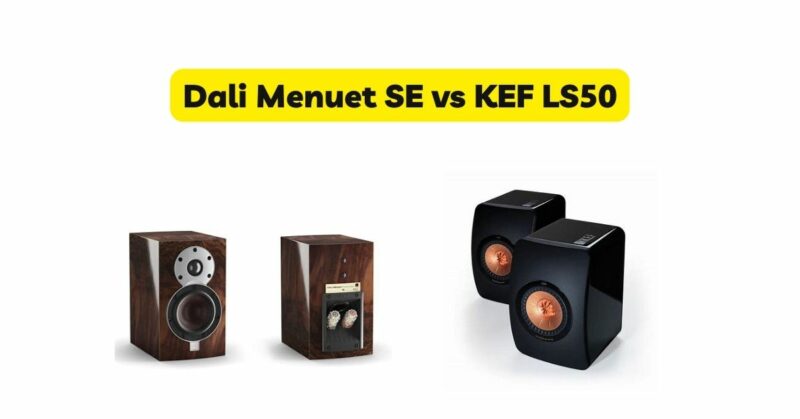When it comes to compact bookshelf speakers, the Dali Menuet SE and the KEF LS50 are two models that have gained widespread acclaim for their exceptional sound quality and innovative engineering. In this comprehensive comparison, we will delve into the unique features, construction, sound performance, and overall value of these speakers. By examining their design philosophies, driver technologies, and sonic characteristics, we aim to help you make an informed decision based on your specific audio preferences and room characteristics.
Design and Construction
Both the Dali Menuet SE and the KEF LS50 exemplify the importance of design and craftsmanship. The Menuet SE features an elegant and compact design, with a solid wood cabinet that enhances its aesthetic appeal. It is meticulously crafted with attention to detail, ensuring a rigid and resonance-free enclosure. The LS50, on the other hand, showcases a modern and minimalist design, with a unique curved baffle and an innovative Uni-Q driver array. Its cabinet construction combines constrained layer damping and bracing techniques to minimize unwanted vibrations. Both speakers exhibit a high level of build quality and attention to detail, guaranteeing longevity and optimal performance.
Driver Technology
The driver technology employed by the Dali Menuet SE and the KEF LS50 sets them apart in terms of sound reproduction. The Menuet SE features a 4.5-inch wood fiber woofer and a 28mm soft dome tweeter, designed to deliver a balanced and detailed sound signature. The drivers are carefully matched to provide a coherent and seamless integration, resulting in precise imaging and instrument separation. The LS50, on the other hand, incorporates KEF’s patented Uni-Q driver array, which places the tweeter concentrically within the midrange driver. This design enables a point source dispersion, creating a more coherent and accurate soundstage. The Uni-Q driver array, coupled with a 5.25-inch magnesium/aluminum alloy woofer, offers exceptional clarity and imaging capabilities.
Sound Performance
Both the Dali Menuet SE and the KEF LS50 excel in delivering impressive sound performance despite their compact size. The Menuet SE offers a well-balanced and neutral sound signature, with a focus on accuracy and detail. It provides a wide frequency response and excellent transient response, making it suitable for a variety of music genres. The LS50, known for its remarkable coherence and imaging, offers a more engaging and immersive sound experience. Its Uni-Q driver array allows for a wider dispersion and a more accurate soundstage, resulting in a more three-dimensional listening experience. The LS50 shines in reproducing intricate details and providing a larger-than-life soundstage.
Bass Response
Considering their compact size, both the Dali Menuet SE and the KEF LS50 deliver impressive bass performance. The Menuet SE, with its 4.5-inch woofer, provides tight and controlled bass reproduction. It offers a surprising amount of low-end extension, ensuring a satisfying listening experience. The LS50, with its larger 5.25-inch woofer, offers deeper bass extension and improved dynamics. It delivers a more impactful and authoritative bass response, making it suitable for genres that demand powerful low frequencies. While the LS50 provides a more substantial bass presence, the Menuet SE delivers a well-balanced and controlled low-frequency performance.
Midrange and High Frequencies
Both the Dali Menuet SE and the KEF LS50 excel in reproducing the midrange and high frequencies with exceptional clarity and accuracy. The Menuet SE’s soft dome tweeter and wood fiber woofer combine to deliver smooth and detailed midrange reproduction. It offers a natural tonal balance and showcases vocal clarity with excellent instrument separation. The LS50’s Uni-Q driver array provides a coherent and seamless integration between the midrange and high frequencies. It offers excellent midrange presence, precise imaging, and extended high-frequency response. The LS50’s tweeter is known for its detailed and refined treble reproduction, adding sparkle and airiness to the overall sound signature.
Comparing Soundstage and Imaging
In terms of soundstage and imaging, both the Dali Menuet SE and the KEF LS50 offer impressive performance. The Menuet SE presents a wide and spacious soundstage, allowing for precise instrument placement and an immersive listening experience. It creates a sense of depth and width that is remarkable for its size. The LS50’s Uni-Q driver array enhances its imaging capabilities, providing pinpoint accuracy and a more three-dimensional soundstage. It offers a larger and more enveloping soundstage, immersing the listener in a captivating sonic experience. While the Menuet SE excels in creating a spacious soundstage, the LS50’s Uni-Q driver array takes imaging to the next level.
Conclusion
In conclusion, both the Dali Menuet SE and the KEF LS50 are exceptional compact bookshelf speakers that offer impressive sound performance and craftsmanship. The Menuet SE stands out with its elegant design, balanced sound signature, and meticulous construction. It provides accurate imaging, tight bass response, and a wide soundstage, making it an excellent choice for audiophiles seeking a compact speaker without compromising on performance. The LS50, with its innovative Uni-Q driver array, offers a more engaging and immersive listening experience. It delivers exceptional coherence, extended frequency response, and a larger soundstage. The LS50’s detailed imaging, dynamic bass response, and refined treble reproduction make it a compelling option for enthusiasts who crave a more expansive soundstage and precise sound imaging. Ultimately, the choice between the Dali Menuet SE and the KEF LS50 will depend on your personal preferences, room characteristics, and desired sonic performance. Both speakers represent the pinnacle of compact bookshelf speaker design and provide an elevated listening experience for discerning music lovers.


